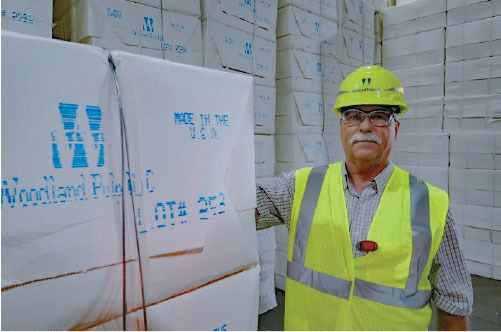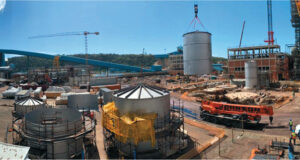
They don’t call Maine “The Pine Tree State” because of the lobsters. About 90 percent of Maine is forest, the highest level of any US state. In the northern part of Maine—the “backyard” of Woodland Pulp LLC—about 12 million acres of trees stretch up past the Canada border. Baileyville, the mill’s hometown, sits along that border, just up the St. Croix River from Passamaquoddy Bay.
Woodland Pulp has been an integral part of Baileyville since the mill was first built in 1906 as a groundwood facility hydro-powered by the St. Croix. It has changed hands a few times since then; International Grand Investment Corp. (IGIC) acquired the mill from Domtar in 2010 for US$64 million. Today, Woodland is the largest market pulp supplier to the Northeast US. Along with its sister mills, St. Croix Chipping and St. Croix Tissue, Woodland Pulp plays a key role in the region’s pulp and paper markets.
When it comes to supply chain management, being the local leader has advantages and challenges. Woodland Pulp managed to navigate both over the past few turbulent years thanks to a strong vision, community engagement, and a solid commitment to sustainability. Paper360° spoke recently to a roundtable of Woodland leaders (see sidebar) about the mill’s success.

P360°: Woodland is unique in so many ways. How do you see your role as a “local leader”?
Heuchling: We have the highest production for market pulp in the Northeast. If you drew a circle from Woodland as far out as western New York, we’re 12 hours away by truck.
Thompson: One part of the supply chain that works really well is that we have pulp within 100-200 miles of many local customers in New Hampshire, southern Maine, northern Maine, and eastern Canada into the Quebec City/Montreal area. We say, a bit tongue-in-cheek, that “you call, we haul.” These customers can place an order today and, under the right circumstances, they can have pulp on their dock by truck tomorrow. That’s a huge advantage for us within that sphere. Some of our New York customers are a bit outside our one-day range, but overall our customers have very good access to our pulp within a day.
We’re also the largest employer in Washington county, and I think the wages at the mill are much better than some other local wages. That’s an advantage.
Beal: Right—and we have a lot of local and legacy employees, with family roots going back to the beginning of manufacturing at this site. IGIC’s VP and manager of East Coast operations and mill manager of St. Croix Tissue and Woodland Pulp, Marty Richard, is a 4th-generation employee and brings that history and passion to the job every day.
Oliver: Another key thing for Woodland pulp is the hydropower operation. Our two big hydro-dams were constructed back in the early 1900s. They supply a significant supply of our power needs. It’s an efficient, renewable form of energy.
You also have two sister companies, St. Croix Tissue and St. Croix Chipping—how does that supply chain work?
Oliver: About 20 percent or so of the pulp we make at Woodland Pulp goes to St. Croix Tissue. About 80 percent is sold externally.
Thompson: The tissue mill services a slightly wider range of customers, from the Southeast to the Montreal/Quebec area—eastern Canada to western New York. We are literally plugged into them with our pulp and with St. Croix Chipping; in terms of supply chain, I would call this a fully integrated operation. We chip the wood, we make the pulp, we feed the tissue mill and we also supply external customers with both tissue and pulp.
Woodland stresses strong environmental performance. Is that important to those external customers?
Beal: There’s no question about that. We are ISO 14000 certified, and we have been since 2000. That was one of the key building blocks to establishing our environmental strategy. It’s no secret that Maine has a pretty detailed and stringent environmental framework for us and the rest of the regulated community to comply with. So, we work very hard to stay off the radar and maintain compliance with our Title 5 air license and Maine’s wastewater discharge license.
We get numerous customer data requests—it’s a guarantee that customers will want detailed information about our environmental impact. It runs the gamut: some customers are more interested in SO2 emissions; other customers are particularly interested in the amount of NOx liberated from our lime kiln, for example. We have continuous emission monitoring systems on all of our fired stationary sources, of course, so we have the data and we make it available. We recognize that our customers have choices.
And of course, this customer information is all on top of the reports we are required to file monthly, quarterly, semi-annually, and annually. On the forestry side, we are PEFC, SFI, and FSC certified. And ISO 9000 on quality—if I don’t add that, the folks in our technical department will be mad at me! A lot of work goes into it.

Scott Beal with one of the mill’s hydro-dams, first operational in the early 1900s.
The site is one of the few that produces bleached hardwood pulp; you also produce some softwood pulp. What makes this the right product mix for Woodland?
Heuchling: From a quality point of view, it just fits. The quality of our hardwood pulp is very good for printing and writing, packaging, specialties, and tissue, with the wood supply we have. What I found, talking to our printing and writing or packaging customers, is that they’d rather use a BNHP in their furnish mix than a eucalyptus pulp. We’re dealing with the species we have in our backyard, and it just fits our customer base and the products that they’re making.
We like to stay as close to home as possible. We work very hard to keep our costs down, whether it’s rail or truck, because it’s all about profitability. We also have an outlet for shipping overseas: Eastport is only 35 miles from the mill. So, if we want to ship overseas—and we do—we have that flexibility.
As a local operation, how did you address the supply chain challenges with your own suppliers, coming out of the pandemic?
Thompson: I can tell you that all of our input costs—chemicals, gases, etc.—went way up. I can speculate that, as a smaller company, we don’t have the negotiating leverage or buying power that some corporations have. At the very beginning of the pandemic, one of the unique challenges for us, being located where we are, is that Canadian truck drivers decided that they didn’t want to cross the border and pick up our product because they were afraid that they wouldn’t be able to get back into Canada. That supply of drivers became very limited, so prices skyrocketed. It became very difficult to service our customers, so we needed to go to a completely different group of carriers to get our product up there.
During the pandemic, we had a very serious, nationwide rail car shortage; there were some mills in Canada that shut down for periods of time because they couldn’t get rail cars—they had to stop producing pulp because they had nowhere to put it. We’re very fortunate that our partner on the other side, New Brunswick Southern Railroad (NBSR), was able to lease rail cars for us, which made it a little easier. I spent a great deal of my time and energy explaining to them why they needed to help us.
Another aspect is that our sales team really went after more customers in Canada. The Quebec/Montreal area is still “local” to us, and developing that area, as well as other customers that we didn’t have before, played to our favor. We have a large pool of truck drivers who literally live in our community, and they have been terrific.
There’s another thing we’ve had to compete with. You’ve heard of Poland Spring Water? Well, they’re 200 miles away, and in the summer, sometimes they’ll move 700-800 truckloads of water out of their southern Maine facility in a day. We need to compete with them, and they have much deeper pockets! But the local companies have done a nice job of trying to support us.
I’m sure that local connection helped. That brings me to another important part of our industry’s supply chain: a capable workforce. Does your strong local presence help there?
Heuchling: Absolutely. We’re very fortunate to be located so close to University of Maine. The Pulp and Paper Foundation at UMaine is the largest in North America. There are nine pulp and paper schools throughout the country, but Maine is twice the size of any of the others, from a Foundation point of view.
We also are active in bringing summer students from UMaine for co-ops/summer intern programs. Both Chuck (Thompson) and Jim (Oliver) sitting at this table are UMaine alumni, as is Marty Richard, whom Scott mentioned. Marty is an excellent leader, and he really helps develop young leaders at the mill. When you have someone with those connections, who is creating a great culture, that’s attractive to prospective employees.
McIver: We have a Career Exploration Day where local high school students are given the opportunity to come to the mill to explore whether they’d want an engineering career through the UMaine Pulp and Paper Foundation. Marty (Richard) and Ray (Heuchling) are on the board; we have other employees who are also involved on different boards at UMaine, and we work closely with Carrie Enos, Pulp and Paper Foundation president. This relationship is definitely a benefit for St. Croix Tissue as well.
What do you recommend that other mills can do to emulate this success with their own local academic institutions?
Heuchling: A lot of major companies in our industry—Graphic Packaging, PCA, Irving—participate on the BOD at the foundation; they do that because of the talent being created at UMaine. Right now, that talent is needed in the pipeline for all their companies, so they participate in a very significant way.
Thompson: I want to add that a lot of the talent that we need here is not necessarily college-graduate folks, so it’s also important for facilities to develop very strong relationships with local community colleges and high schools. That talent pipeline needs to start early in these students’ lives. They need to be exposed to this industry to see what it does, and to understand that there are good jobs and a decent living even without going to the university. When companies have a strong connection to the community colleges, working to develop a program that begins to prepare young people for an hourly-level career in a mill—that’s very helpful.
McIver: We work with Washington County CC and Eastern Maine CC. When we go to career fairs and job fairs at the local high schools, we talk to students about electrical courses they can take that might help them. There’s actually a Production Technician course that they can take at WCCC; they put that course in place after our tissue machine started up. They have different courses in heavy equipment operations, maintenance, and more.
Heuchling: This is exactly what the whole industry needs right now: exposure, then engagement. The model we have with the University of Maine is probably the most ideal, so we’re very fortunate.
There’s a lack of talent in the pipeline right now. That’s one reason pulp and paper gets so much attention in Maine: employment opportunities. But training takes a long time. Scott, when a new employee jumps on board, how long does it take to train that employee to do what you want them to do?
Beal: At least six months, some as long as a year. And it helps if they know the basics when they come on.
What is Woodland Pulp’s greatest advantage as a “local leader”?
Heuchling: Last year, we were the largest market pulp supplier to the Northeast; out of the 300 thousand tons of market pulp in this region, we were shipping about 250 thousand tons of that. This is our backyard. That’s unique. We can make decisions very quickly, and that’s important. Everyone we work with should know that our doors are open; customers are welcome to tour the mill and see where their products are coming from.
Thompson: Yes—we’re nimble. Regarding supply chain, one goal I was given when I came here was to adapt our infrastructure so that we could turn on a dime. Today, we can ship by rail, ocean, truck—that’s something we have accomplished. We’ve built up our carrier supply base. So, if the market turns so that we need to export, or if the market turns so that we need to do only domestic, we can do that very quickly. It’s a huge advantage.
 Paper 360
Paper 360


